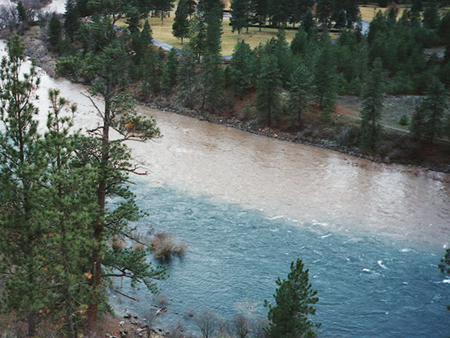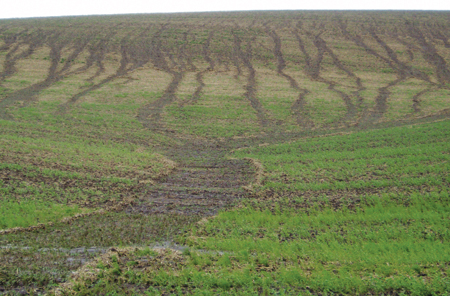Latah (Hangman) Creek looks more like chocolate milk than water
this time of year. It’s that color be cause it is carrying millions of tons of topsoil as it oozes its way through the Palouse farming areas of Idaho and on through Whitman and Spokane Counties in Washington. There is some natural erosion taking place, but the vast majority of the topsoil being carried in the creek is from farmed ground. When it reaches the confluence with the Spokane River just west of downtown Spokane, it flows as a wide, brown ribbon along the south bank for about a mile before it starts to mix with the green ribbon of the Spokane River. Erosion is a very natural process of nature and not necessarily bad. The effects of wind and water on rock are what, over the course of several millions of years, have made and deposited the rich loess soils of the region we call the Palouse in Eastern Washington. But in just over a hundred years of farming, nearly half of the soils that were there, are now gone, washed and blown away. What we are witnessing now is alarming and unnecessary.
cause it is carrying millions of tons of topsoil as it oozes its way through the Palouse farming areas of Idaho and on through Whitman and Spokane Counties in Washington. There is some natural erosion taking place, but the vast majority of the topsoil being carried in the creek is from farmed ground. When it reaches the confluence with the Spokane River just west of downtown Spokane, it flows as a wide, brown ribbon along the south bank for about a mile before it starts to mix with the green ribbon of the Spokane River. Erosion is a very natural process of nature and not necessarily bad. The effects of wind and water on rock are what, over the course of several millions of years, have made and deposited the rich loess soils of the region we call the Palouse in Eastern Washington. But in just over a hundred years of farming, nearly half of the soils that were there, are now gone, washed and blown away. What we are witnessing now is alarming and unnecessary.
A hundred years ago the only way to farm the rolling hills of the Palouse on a large scale was with horses and oxen. The technology of the day was primitive by modern standards, but quite effective in opening up large tracts of land for production of crops. Unfortunately, one piece of that primitive technology that turned over millions of acres of native prairie in the Palouse and other areas of the country is still in use today; the plow.
When farming first started on the Palouse, it was limited to the fertile lowlands along streams and rivers. It wasn’t long, probably the first winter and spring after being plowed, that the Palouse started losing topsoil at rates of multiple tons per acre per year. Once the native prairie was destroyed and the soils were no longer protected by permanent vegetative cover, severe erosion was not only possible but predictable. Mechanization allowed the farming operations to move up the sides of the hills, leading to increased production but at the cost of dramatically higher rates of erosion. The fragile riparian areas lining the banks of the rivers and streams were populated by thick groves of trees along with native shrubs and grasses which served as filters, keeping some of the soil out of the waterways. But as erosion rates increased and as farmers cleared those lands along the creek, the precious topsoil was swept into the water and transported downstream. The sediment load behind Nine Mile Falls Dam is enormous, stretching for miles back to the east and well over 100’ deep behind the dam.
On a typical “c onventional tillage” farm, anywhere from 4-7 trips over the same field are required to establish a crop; plowing, chiseling, harrowing a couple of times, seeding and fertilizing. Since the early 1970’s there has been an effort to reduce the amount of erosion on the Palouse by reducing the number of tillage operations on the ground to one or two. Farmers have the technology available to them that allows them to place the seed and fertilizer in the ground directly through the residue of the previous crop. With direct seeding or no-till, the soil is never exposed to the effects of wind or water erosion with the residue providing excellent protection. An added bonus is all the water that falls on the ground is water that is available to the crops because it soaks in instead of running off. By establishing a crop in one pass over the ground, the savings in fuel consumption alone more than pays for the equipment, let alone saving the precious topsoil of the Palouse.
onventional tillage” farm, anywhere from 4-7 trips over the same field are required to establish a crop; plowing, chiseling, harrowing a couple of times, seeding and fertilizing. Since the early 1970’s there has been an effort to reduce the amount of erosion on the Palouse by reducing the number of tillage operations on the ground to one or two. Farmers have the technology available to them that allows them to place the seed and fertilizer in the ground directly through the residue of the previous crop. With direct seeding or no-till, the soil is never exposed to the effects of wind or water erosion with the residue providing excellent protection. An added bonus is all the water that falls on the ground is water that is available to the crops because it soaks in instead of running off. By establishing a crop in one pass over the ground, the savings in fuel consumption alone more than pays for the equipment, let alone saving the precious topsoil of the Palouse.
The irony of a $300,000 tractor with satellite guided GPS auto-steering, climate controlled cab, computers and all the comforts of a living room pulling hundreds of years old technology, a plow, is clearly evident as is the erosion it causes. The plow needs to go. Saving water, saving soil, saving money and maybe even saving the farm, No-Till is the environmentally responsible way to farm.
.jpg)
Jim Armstrong
FarpointsFarm@gmail.com
© Copyright 2025 | All rights reserved | Privacy Policy
"We do not share any client data with third parties. Your personal information is kept confidential and is not disclosed to any outside organizations except as required by law or with your explicit consent."
